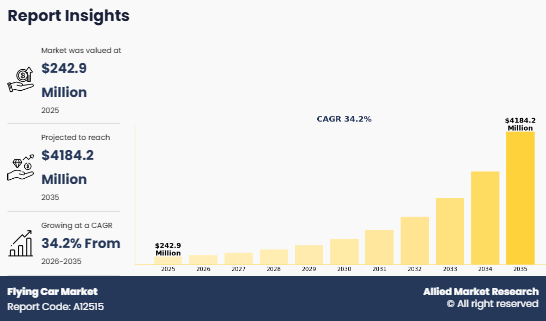Flying Car Market Overview
The global Flying Car Market size was valued at USD 242.9 million in 2025, and is projected to reach USD 4184.2 million by 2035, growing at a CAGR of 34.2% from 2026 to 2035. The flying car market is driven by shifting urban mobility trends and rising investments from key players. However, high development costs and strict aviation regulations hinder growth. Emerging opportunities in Asia-Pacific and growing industry partnerships are expected to fuel future expansion.
Key Market Trend & Insights
Piloted flying cars dominated the market in 2025 due to current technological limitations and fewer regulatory hurdles compared to autonomous operations.
Commercial & professional commute led the end-use segment in 2025, driven by strong demand from services like air taxis, emergency transport, and business travel.
Flying cars with more than six seats captured the largest share by seating capacity in 2025, favored by commercial operators aiming to boost efficiency and profitability.
Europe led the regional market in 2025 owing to early adoption of urban air mobility, strong government backing, and substantial infrastructure investments.
Market Size & Forecast
2035 Projected Market Size: USD 4184.2 million
2025 Market Size: USD 242.9 million
Compound Annual Growth Rate (CAGR) (2026-2035): 34.2%
Market Introduction and Definition
A flying car is a type of hybrid vehicle that functions both as a road vehicle and an aircraft. It combines features of a car, such as an engine, four wheels, and seats, with the ability to take flight like an aircraft. These vehicles are typically designed to operate in congested urban areas or for long-distance commutes, offering the flexibility to switch between driving on roads and flying in the air.
Flying cars are also known as "roadable aircraft" and can have both fixed-wing and rotary-wing configurations, providing a unique mobility solution in the future of transportation. While many flying cars are still in the development or prototype phase, they represent an advanced concept aimed at solving traffic and mobility issues.
Key Takeaways
- The Flying Car Market Size study covers 20 countries. The research includes a segment analysis of each country in terms of value for the projected period.
- More than 1, 500 product literatures, industry releases, annual reports, and other such documents of major dental industry participants along with authentic industry journals, trade associations' releases, and government websites have been reviewed for generating high-value industry insights.
- The study integrated high-quality data, professional opinions and analysis, and critical independent perspectives. The research approach is intended to provide a balanced view of global Flying Car Industryand to assist stakeholders in making educated decisions in order to achieve their most ambitious growth objectives.
Market Dynamics
The era of self-driving cars, where cars come to pick up people and take them to their destinations, is approaching. A number of automobile companies and IT companies, including Google, are participating in the development of autonomous vehicles. The era of self-driving cars will become a future that everyone is familiar with. And now, a new means of transportation that goes beyond self-driving cars is attracting attention. After IT companies such as Google and Uber took the lead and showed interest in flying cars, interest in flying cars is growing, especially in the United States. Flying car is a concept that has recently emerged and there is no fully agreed definition yet.
Flying car is the new era of urban mobility solution type that operates on road as well as air, as per the requirements. The majority of the future flying car solutions are expected to be equipped with vertical takeoff and landing systems to avoid long runway requirements to take off, as well as it can be mold with urban infrastructural structure. Policy makers need to introduce regulations and rules to comply with the changing need for urban commute solutions that involves both aviation as well as road transportation policies. Flying car have a wide range of applications, including passenger commute, commercial transport such as air taxi, and professional transport such as police, medical service front. In the upcoming era, infrastructural development is expected to be more critical than product development.
Factors such as changing urban mobility outlook and increasing investment by the market players are expected to drive the growth of the flying car market. However, the high development cost of flying cars and implementation of stringent regulations for aviation license restrain the market growth. On the contrary, increase in agreements & contracts and high untapped potential in Asia-Pacific are projected to offer lucrative growth opportunities for the Flying Car Industry players.
However, in relation to flying cars, optimistic predictions about the operation of aerial vehicles are predicted when the VTOL (Vertical Take-off and Landing) type of technology is introduced. On the other hand, in order to settle as a convenient means of transportation with the introduction of flying cars, the government's active policy change is necessary. It is necessary to build a dedicated space for PAV (Personal Air Vehicle) for vertical take-off and landing in the city. It is also essential to establish a place to charge the PAV's electricity. It is also necessary to enact systems and laws in parallel with the establishment of such infrastructure. Most countries have so far established systems and laws centered on automobiles, a means of transportation. A work must also be done to make these systems and laws fit the environment of the flying car, a new means of transportation. It is expected that it will take time for the construction of infrastructure for flying cars and the work of enacting systems and laws. If flying cars are commercialized, there is a possibility that traffic jams on the ground will occur in the sky. It is also essential to develop a system that can efficiently manage and control such traffic jams in the air. Flying cars are expected to make human life more convenient as a new means of transportation along with autonomous vehicles.
Recent Develoment in Flying Car Industry
Recently, many companies are participating in the development of flying car technology. In addition, recently, not only automobile companies but also light airplane manufacturers are investing in related technology development which brings myraid Flying Car Market Opportunity. Uber recently sold Uber LEBATE (air taxi) to Joby Aviation. These are these changes, but the big trend is that related companies are increasing their investment. Companies that participated in the development of flying cars and launched prototypes are as follows.
Nation | Company | Model | Explanation |
USA | Joby | Joby S4 | - aim to develop a fully charged 'electric flying car'. -developing technology to enable vertical take-off and landing. - Aviation's 'Electric Vertical Takeoff and Landing (eVTOL)' planes are being tested. |
China | Ehang | Ehang 184 | - one-person drone, less than 100kg, 25 minutes and 50km driving, drone call taxi test operation in Dubai - made of lightweight material and weigh only 200 kg. Top speed is 100 km/h |
Netherlands | PAL-V | Liberty | - mass production flying car with foldable propellers, use flight engine, a non-electric, require a runway of 200m or longer, Pilot qualification required, the maximum flight speed is 160 km/h. maximum driving speed is 180 km/h |
China | Terrafugia | The Transition | - A flying car company acquired by Geely Motors, a combination of a light aircraft and a sports car. possible to switch between driving/flight mode in 1 minute, two passengers, maximum flight distance is 643 km, maximum flight speed is 160 km/h |
Market Segmentation
The global flying cars market is segmented into mode of operation, end use, seating capacity, and region. By mode of operation, the market is divided into piloted and autonomous. Depending on end use, it is bifurcated into commercial & professional commute and personal commute. Based on seating capacity, it is segregated into one, two, four, and more than six. Region-wise, the market is analyzed across North America, Europe, Asia-Pacific, and LAMEA.
Mode of Operation
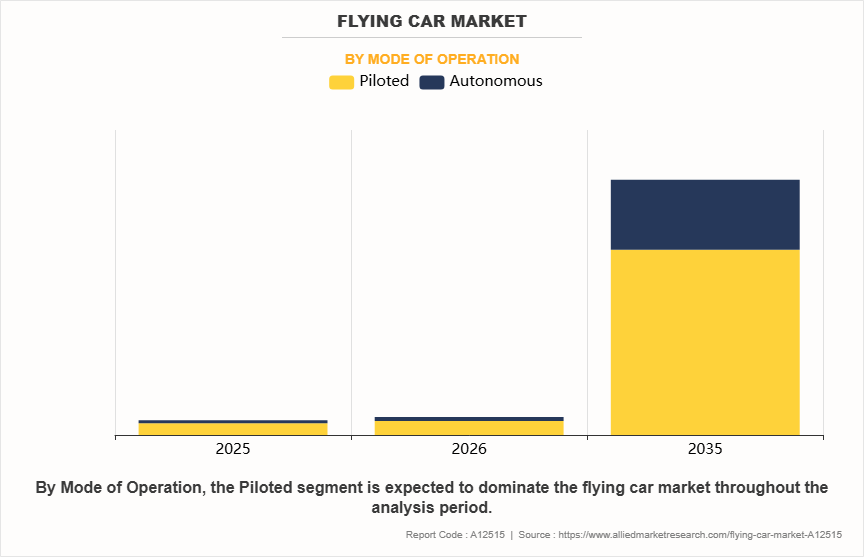
Based on Mode of Operation, the Piloted segment had the dominating Flying Car Market Share in the year 2025. This is attributed to the current limitations in autonomous technology, including safety concerns, regulatory challenges, and a lack of infrastructure to support fully autonomous flying cars. As a result, piloted operations dominate due to their reliability and lower regulatory hurdles.
End Use
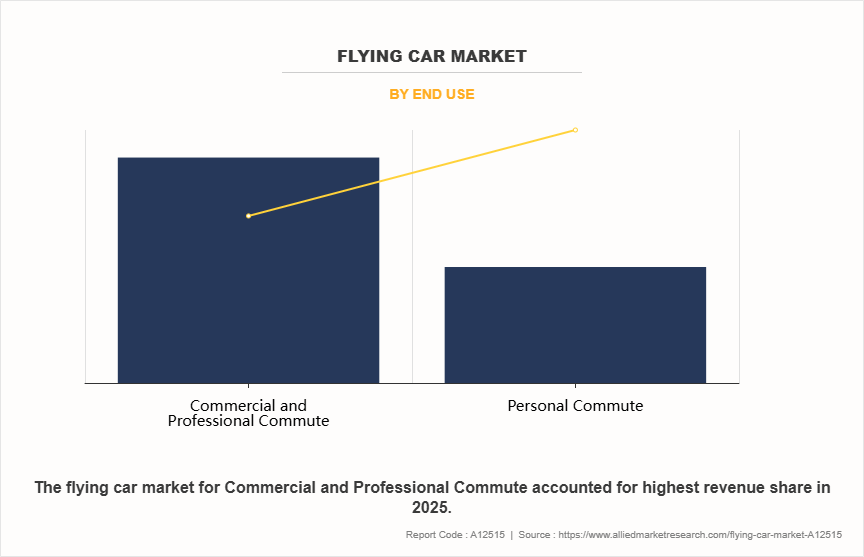
Based on End Use, the Commercial & Professional Commute segment will dominate the global market in the year 2025 and is likely to remain domiant during the Flying Car Market Forecast. This is attributed to the higher Flying Car Market Demand from professional services such as air taxis, emergency medical transport, and corporate travel, where flying cars offer efficiency, reducing travel time significantly compared to personal use.
Seating Capacity
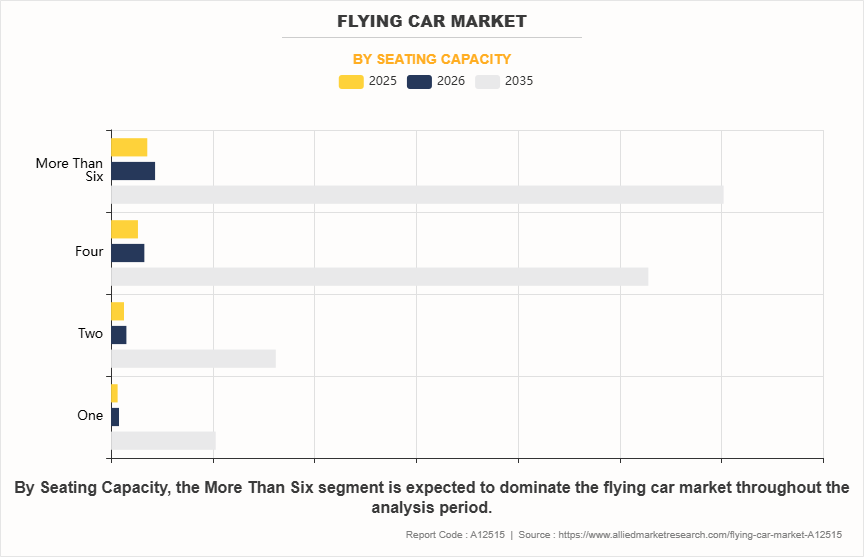
Based on Seating Capacity, the More Than Six segment will dominate the global market in the year 2025. This is attributed to the demand for flying cars with larger seating capacities, especially for commercial operations like air taxis, where transporting multiple passengers simultaneously increases profitability and meets customer demand for group travel.
Region
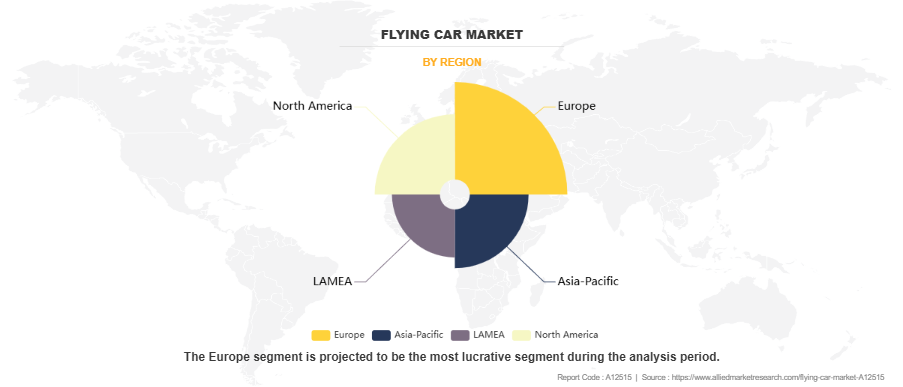
Based on region, the Europe segment will dominate the global market in the year 2025. This is attributed to Europe’s early adoption of advanced urban mobility solutions and government support for innovative transportation systems, along with a high level of investment in infrastructure for flying cars.
Which are the Top Flying Car companies
The following are the leading companies in the market. These players have adopted various strategies to increase their market penetration and strengthen their position in the flying car industry.
AeroMobil
Airbus S.A.S.
Hyundai Motor Company
Klein Vision s.r.o.
Lilium
PAL-V N.V.
Samson Motors, Inc.
Terrafugia
The Boeing Company
Volocopter GmbH
Key Benefits for Stakeholders
- This report provides a quantitative analysis of the market segments, current trends, estimations, and dynamics of the flying car market analysis from 2025 to 2035 to identify the prevailing flying car market opportunities.
- The market research is offered along with information related to key drivers, restraints, and opportunities.
- Porter's five forces analysis highlights the potency of buyers and suppliers to enable stakeholders make profit-oriented business decisions and strengthen their supplier-buyer network.
- In-depth analysis of the flying car market segmentation assists to determine the prevailing market opportunities.
- Major countries in each region are mapped according to their revenue contribution to the global market.
- Market player positioning facilitates benchmarking and provides a clear understanding of the present position of the market players.
- The report includes the analysis of the regional as well as global flying car market trends, key players, market segments, application areas, and Flying Car Market Growth strategies.
Flying Car Market Report Highlights
| Aspects | Details |
| Market Size By 2035 | USD 4184.2 million |
| Growth Rate | CAGR of 34.2% |
| Forecast period | 2025 - 2035 |
| Report Pages | 297 |
| By Mode of Operation |
|
| By End Use |
|
| By Seating Capacity |
|
| By Region |
|
| Key Market Players | Boeing, Hyundai Motor Company, Lilium GmbH, PAL-V, AeroMobil, Klein Vision, s.r.o., Samson Sky, Volocopter GmbH, Airbus, SkyDrive Inc. |
Analyst Review
According to the perspectives of CXOs of the leading companies, the global flying car market is expected to witness significant growth, due to rising demand for alternative urban transportation solution, changing mobility outlook, and growing adoption of aviation solutions. Market players of the flying car market are focused on developing the flying car solutions. Development of the flying car is associated with high capital investment as well as need an expertise from automotive as well as aviation industries. To meet these requirements, market players are entering into the partnership with the other market participants and public service providers and are raising the funds through various investment avenues.
Numerous developments have been carried out by top companies, such as PAL-V N.V., Lilium, The Boeing Company, Volocopter GmbH, and Hyundai Motor Company, which have supplemented the growth of the global flying car market. In addition, AeroMobil flying car is expected to be available for purchase from 2023. Market participants have adopted agreement, business expansion, partnership, and product development to meet the upcoming requirements.
The global flying car market Size was valued at $242.9 million in 2025, and is projected to reach $4184.2 million by 2035.
The global flying car market is projected to grow at a compound annual growth rate of 34.2% from 2026-2035 to reach $4184.2 million by 2035.
The key players that operate in the flying car market such as AeroMobil, Airbus S.A.S., Hyundai Motor Company, Klein Vision s. r. o., Lilium, PAL-V N.V., Samson Motors, Inc., Terrafugia, The Boeing Company, and Volocopter GmbH.
Factors such as changing urban mobility outlook and increasing investment by the market players are expected to drive the growth of the flying car market. However, the high development cost of flying cars and implementation of stringent regulations for aviation license restrain the market growth.
Loading Table Of Content...
Loading Research Methodology...

